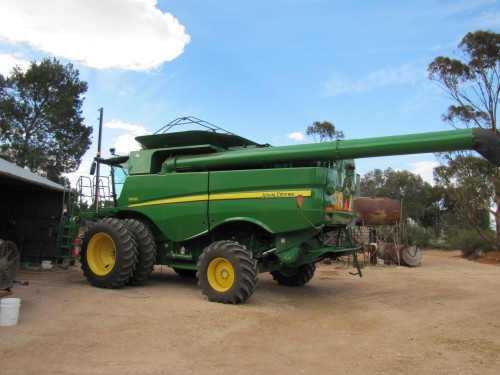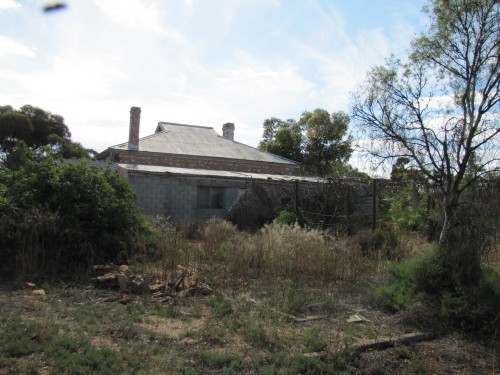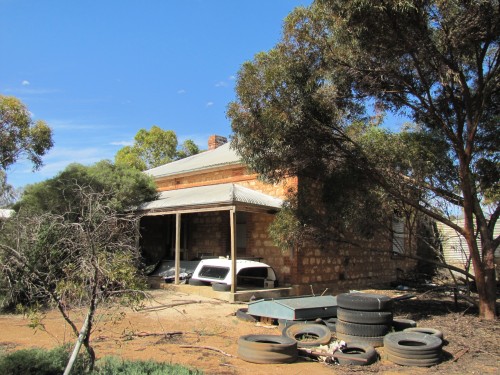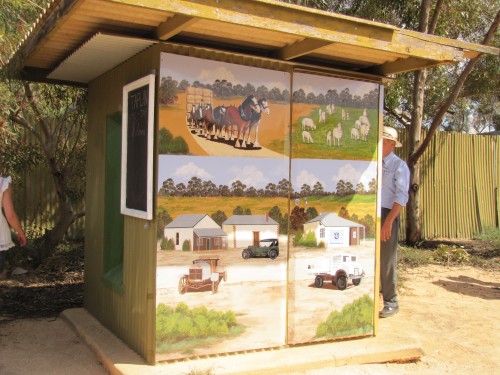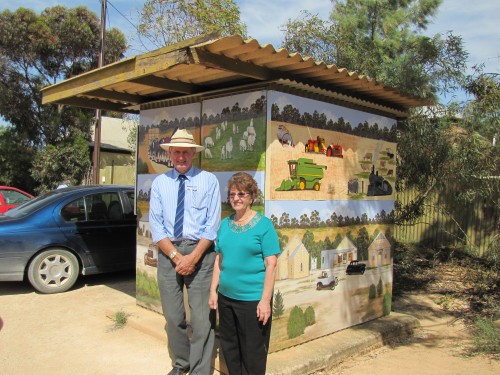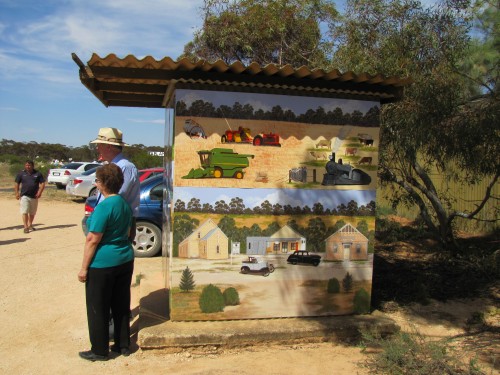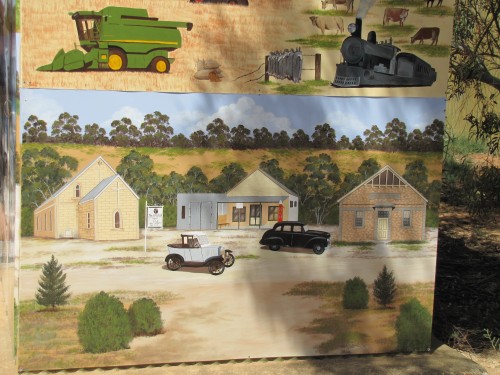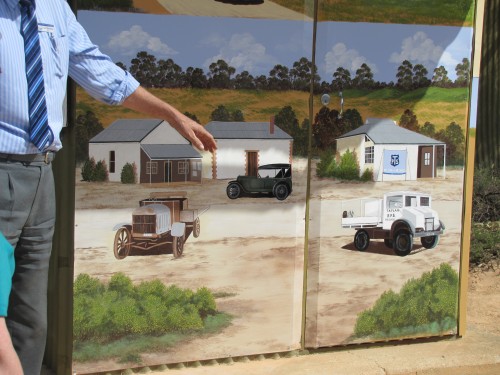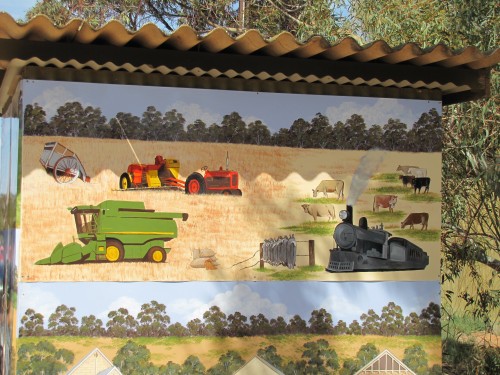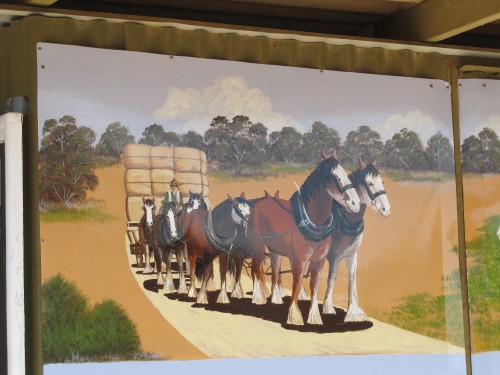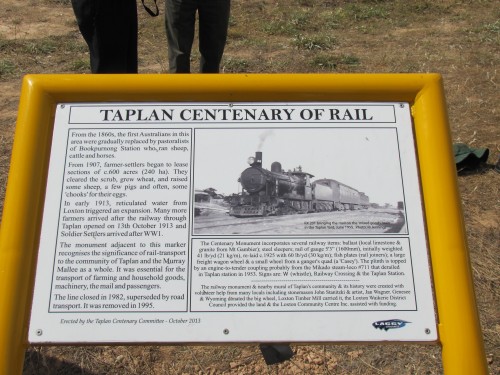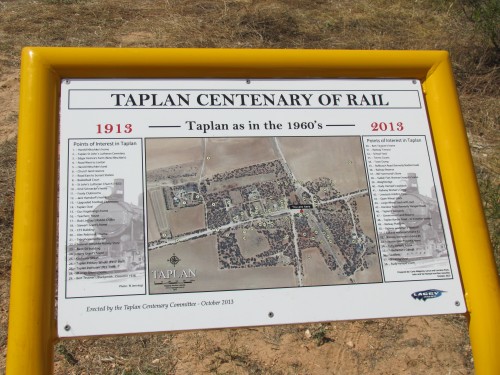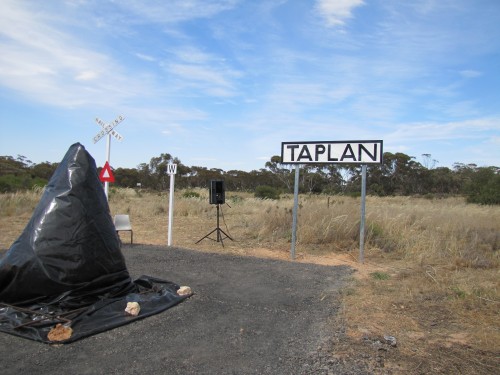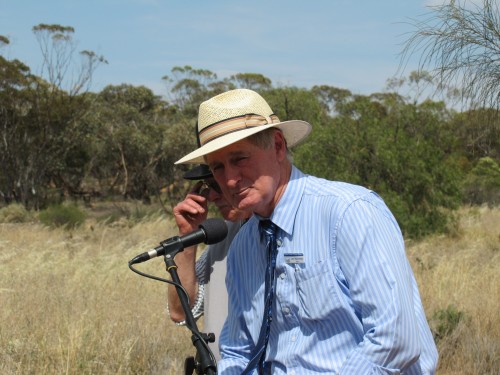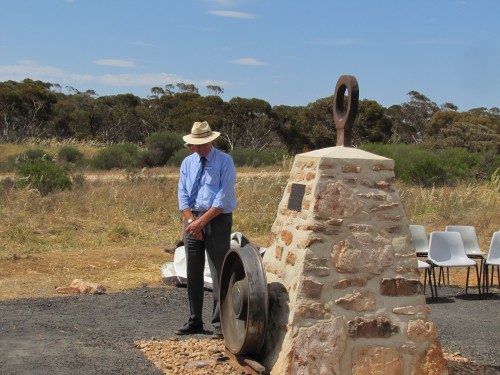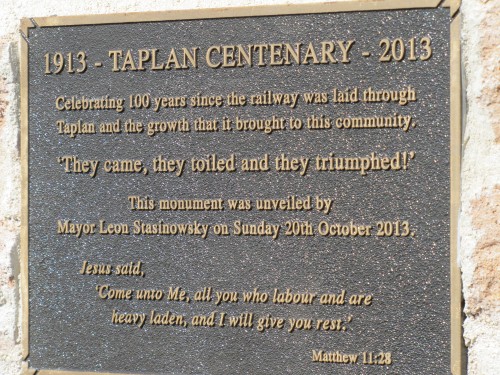Modern farming machinery at Taplan
The last time I visited Taplan was during the Railway Centenary Celebrations in October 2013. Taplan is a small farming community about 30km south-east of Loxton in South Australia. I have written extensively of this town and district in recent days here on this site. Taplan is the small town where I grew up on my father’s farm. When my father retired into Loxton, my brother took over the family farm. When he retired my nephew took over and his sons look like keeping the trend going in the years to come.
On that last visit my brother took me to my nephew’s farm to show me the harvester (see photo above) he uses when reaping the cereal crops, mainly wheat and canola. A machine like this is expensive, somewhere in the region of three-quarters of a million dollars. He has since traded this machine in on a new one.
Sometimes my brother and I reminisce about the days when our father started out farming. He started in the late 1920s with a six foot (1.8 metre) comb on his wheat harvester. It was pulled by a team of horses. The new machine does cuts 54 feet wide (16.45 metres). And he doesn’t actually have to “drive” it because it is GPS guided with constant computer analysis of the yield of each section of the paddock. Our father would not believe what my nephew is doing to improve the productivity of the land he once farmed, or the machinery he now uses.
Even I can hardly believe it.
Where I grew up at Taplan
Taplan is a small farming community about 30km south east of Loxton in the Murray Mallee region of South Australia. The town was established in the early 1900s and was the result of clearing much of the mallee (eucalyptus) scrub over many years of hard work. These days the area is mainly a cereal growing area – wheat, barley, canola and some oats. Some sheep and cattle are also kept by local farmers.
I grew up in this town in the 1950s and 60s. Over recent days on this site I have written about school life and other aspects of life in this small community. Today the town is a mere shadow of its former self. Many houses are now empty, including the one shown in today’s photos, the Institute Hall and the primary school are now private residences, the post office and store have closed and the only church (Lutheran) often has only half a dozen people attending. The railway ceased operating some years ago too.
My parents moved to this district when they married in the late 1920s. My father farmed the family land, initially about 600 acres but later over 1000 acres as he bought adjoining properties. My brother bought another farm a few miles to the north when he married. Later, when another brother married he bought the original farm from my father. Both of these properties have since been bought by my nephew who has expanded even further with several more properties bought in recent years. It seems quite likely that one or more of his three sons will soon be working these properties with their father.
The old homestead shown in today’s photos is where I grew up from 1947 until my parents and I moved to Loxton in 1965. During those years I enjoyed a wonderful childhood playing around the house and helping my mother in the garden. Our extensive garden included many fruit trees, such as:
- oranges
- lemons
- mandarins
- nectarines
- apricots
- peaches
- pears
- loquats
- figs
- grapes
- passion-fruit
In the vegetable garden we grew:
- carrots
- cauliflower
- cabbage
- lettuce
- pumpkins
- watermelons
- rockmelons
- beetroot
- tomatoes
- turnips
- and probably quite few I have forgotten.
We had a small herd of cows but I never had the job of milking them. My job was to take the milk, pour it into a separator and turn the handle until the cream was separated from the milk. Sometimes I helped my mother make homemade butter. Any leftover milk was given to the small herd of pigs which were also our source of meat. Very rarely did we eat our own ham or bacon. More often it was either poultry – such as chicken or duck – or mutton from sheep which my father would butcher. Any excess cream was sold, the large cans of cream being transported to Murray Bridge (where I now live) by train in refrigerated vans.
The chickens – we always called them “chooks” – were largely my responsibility. While I did provide them with some wheat or other grain to eat, most of the time the chooks foraged in the garden, around the sheds or even out in the nearby paddocks. We invented “free range eggs” before it was fashionable.
My job every evening was to “look for the eggs”. I didn’t just have to gather the eggs from the laying boxes in their shed, I actually had to actively search out where they were laying. This could be anywhere in the implement sheds, in farm machinery, behind boxes, under bushes – I had to use my keenly developed eyesight to watch where the hens were so I could find their eggs.
I was not always as alert as the hens were cunning. They would lay their eggs in a secret place until they had ten or fifteen, and then they would go “broody”. I quickly learned that the peck of a broody hen hurt, so often I would leave them be. A few weeks later a new batch of fluffy chickens would grace our farm yard. In this way we replenished those we had eaten. Of course we always had far too many eggs and no matter how many wonderful cakes and biscuits mum made, there was always an excess, and these I had to wipe clean with a damp cloth before packing them in specially designed crates. These crates were taken to the nearby railway station and transported off to markets in Adelaide.
The area immediately surrounding the house and sheds of our homestead consisted of a large patch of native mallee (eucalyptus) scrub. I am much younger than my three brothers who were never much interested in playing with me when I was growing up, except when I was a baby. During my school days I had to entertain myself during school holidays and on weekends. The nearby scrub kept me very entertained as I explored it, developing a love of the environment which persists to this day. I now own a little patch of mallee scrub where I now live in Murray Bridge. You can see photos of birds seen around my home on Trevor’s Birding.
The last photo I will share today is another view of the house on the farm where I grew up. It is now a ruin; my brother built a new house just a few metres north of this one a few years after he married. It is sad to see so many similar old homes like this one going to ruin, but that is just the way things are; there is no use bemoaning the fact that maintenance on old houses is expensive, and there is just not the concentration of population in rural Australia to keep houses like this occupied.
Taplan mural paintings
As a part of the Taplan Railway Centenary celebrations in 2013 there was special mention made of the new murals painted on the telephone exchange building. This small structure, shown in today’s series of photos taken on the day, replaced the old manual telephone exchange in the nearby post office many years ago. This building also doubles as a mail centre, the letters being sorted regularly into a handful of post office boxes in the side of it.
When I was growing up in the 1950s and 60s I would walk past this spot twice every day on my way to and from school a few hundred metres away. Behind this modern structure is the old post office where I would stop every day on my way home to collect the mail from a window, behind which the post master sat. His job every day would be to sort the few dozen letters addressed to residents in the area. He also manned the manual telephone exchange, connecting incoming calls to the number being called.
The phones in the homes of the district were typical of many used throughout rural Australia of that era. A bulky wooden cabinet hung on the wall in our dining room, with a large mouthpiece and a cord attached to an earpiece. When there was an incoming call, the phone would ring loudly and to answer one picked up the ear piece from its cradle and spoke into the mouthpiece. The person manning the exchange then connected the caller. To make a call one would pick up the earpiece and turn a handle, alerting the person in the exchange that you wanted to make a call, which they then connected for you. My parents would be astounded by the modern mobile phone and the many things one can do on one.
In the photos below I have show the new murals from different angles. One photo shows the artist and the Mayor of Loxton Waikerie who declared the murals open. The paintings, based on local scenes and local farming equipment down through the years, show typical scenarios of life in the Taplan region.
Taplan Railway Centenary Celebrations part 6
This interpretive sign was placed in position near the plaque celebrating the centenary of the opening of the railway line through Taplan, south east of Loxton in eastern South Australia. (Click to enlarge the image.)
The Taplan area in the Murray Mallee region of my state is a predominantly cereal growing area, supplemented by sheep and cattle. The opening of the railway line in 1913 accelerated the growth of the town and the surrounding farms. Its introduction meant quick access to markets for the products produced, as well as easy transport of farming supplies needed.
When I was growing up on my father’s farm in the 1950s and 60s, the town was still a busy community. Every day on my way to school and home again I would walk past this very spot where these signs now stand. The school was a one room, one teacher rural school with about 30 children attending. It closed many years ago and the few children left in the community now go to school in Loxton by bus.
The interpretive sign shown in the photo below shows an aerial photo of Taplan taken in the 1960s. It shows my father’s farm homestead in the lower right hand corner of the photo. Our farm is shown as the cleared land in the lower part of the photo – of course, this was only a small portion of the whole farm which stretched several miles in either direction east and west of the town, and about a mile to the south, some 2000 acres in all.
Taplan Railway Centenary Celebrations part 5
After all of the speeches the visitors to the Taplan Railway Centenary celebrations moved down the main street to near the old Post Office. Here a special memorial plaque and historic monument had been set up as well as some signs.
The signs in the photo above show (from the left):
- the Railway Crossing warning sign for the road crossing
- the W sign indicating to the train driver to blow the train’s whistle as he approached the crossing
- the Taplan station sign.
All of these have been relocated from their original positions so that they can be near the displays and memorial. The official unveiling and opening was performed by Mayor Leon Stasinowsky (below) on the 20th October 2013.
